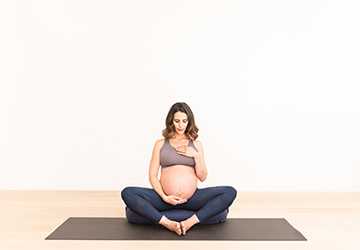Reducing Pregnancy-Related Back Pain: Effective Stretches and Exercises
Pregnancy is a beautiful process, but at the same time, it brings a lot of complaints and pain, including back pain; this is a very familiar problem among expectant mothers, and it causes a lot of discomfort and restricts mobility.
To achieve optimum health, it is essential to find practical and effective means of dealing with back pain during pregnancy. Specific stretches and exercises can help minimize irritation and improve the outcome in the long run.

This blog post will explore important information about safely preventing and dealing with back pain while pregnant. Keep reading to learn how to make your pregnancy a little more comfortable.
5 Stretches and Exercises for Pregnancy Back Pain Relief
It is well understood that integrating specific stretches and exercises into the daily schedule may significantly decrease pregnancy associated with back pain.
Now, let us discuss some practical methods for reducing discomfort and ensuring a better pregnancy life.
1. Cat-Cow Stretch
It is gentle and one of the most helpful back pain relievers during pregnancy. This movement can help stretch the spine and release tension in the back muscles, resulting in better posture.
To perform the Cat-Cow stretch:
● First, you should get into a cat or table position with your hands and knees.
● Breathe deep, push your back forward, and lift your head.
● The cat position: blow out, arch your back, and pull your chin in.
● This is followed by 10-15 repetitions of the above actions.
The Cat-Cow pregnancy stretch is beneficial when performed daily as it helps maintain the spine's flexibility and keeps the back muscles relaxed.
2. Pelvic Tilts
An excellent example of pelvic tilt is the exercise that effectively strengthens the abdominal muscles and relieves the pain in the lower back. The efficiency of this exercise also enhances the spinal posture, which is vital during pregnancy.
To perform pelvic tilts:
● Lay on your back with both feet flat and your knees bent.
● 'Suck in' your tummy and try to make your back as flat as possible on the floor.
● Inhale for 2-3 seconds and then exhale and release.
● To consolidate, repeat for 10-15 repetitions.
Practising pelvic tilt exercises can benefit your body significantly when your belly is growing big due to pregnancy, as they can help relieve lower back pain.
3. Child's Pose
This is a gentle stretch that is quite helpful for women who are experiencing common backaches during pregnancy. It is particularly effective in stretching the lower back and hips and relaxing the body and mind.
To perform the Child's Pose:
● Stand with your feet closely placed and your toes curled, then slowly bend your legs at the knee and bring your knees together.
● To get back into the previously described position, sit back on your heels, then extend your arms in front of you, resting your forehead on the floor.
● Maintain the position for about half a minute to one minute, but remember to breathe throughout.
Child's Pose is an excellent way to relieve tension in the back and even take a break from your daily routine.
4. Prenatal Yoga
Prenatal yoga is perfect for alleviating back pain and is highly beneficial for pregnant women. It is also a way to ensure that you are doing the proper back and core muscle exercises, either by attending a prenatal yoga class or following a prenatal yoga video.

Some beneficial poses include:
● Warrior II: Improves the leg and muscle strength of the abdomen and back.
● Triangle pose: Stretches the sides of the body and encourages the spine to move more freely.
Prenatal yoga is an exercise that can help strengthen muscles throughout the body, decrease anxiety, and promote a healthy pregnancy.
5. Wall Squats
Wall squats are also good for the legs and lower back, and even if you are pregnant, back pain may be relieved by this kind of exercise. They also enhance the ability to sit or stand straight and increase steadiness.
To perform wall squats:
● Place one foot at a time parallel to the wall located at a distance of your shoulder width.
● Slide down a wall, gradually seating yourself on your buttocks.
● Climb the ladder briefly and then return to the initial position.
● Repeat that for 10-15 repetitions.
Including wall squats in your fitness regime can help reduce pressure on the lower back while enhancing your strength.
Start Managing Pregnancy-Related Back Pain Today!
You do not have to endure back pain as a resident pregnancy symptom throughout your pregnancy journey.
By including these helpful stretches and exercises in your daily regime, you may find relief from the discomfort, enhance your health, and, ultimately, have a more comfortable pregnancy.
Do not let this back pain prevent you from enjoying this precious period. Do not wait for the problem to worsen. Get ready now. Your baby and your body will appreciate your efforts, and you will always feel more comfortable.
Frequently Asked Questions
Q. When should I consult a doctor about pregnancy-related back pain?
Ans. If your back pain is sharp, unrelenting, and associated with features suggestive of an underlying medical condition such as fever or vaginal bleeding, please seek medical advice. They can recommend the necessary changes and exclude the presence of any other pathology.
Q. Are these exercises safe for all stages of pregnancy?
Ans. In most instances, these exercises are not dangerous when pregnant. However, it is always advisable to consult with your doctor before taking up any new exercise regimen to confirm whether it is safe for you and the pregnancy period you are in.
Q. How often should I perform these stretches and exercises?
Ans. Try introducing these stretches and exercises into your practice and do it for a few minutes each day. Pay attention to your body and decrease training volume and intensity if you feel uncomfortable or experience pain.
Q. Can I modify these exercises if they cause discomfort?
Ans. Yes, it's always good to pay attention to your body and make adjustments to the exercises you are doing. When a specific stretch or exercise is uncomfortable, it is recommended to change the position slightly or lessen the extent of the stretch. In every situation, make sure your needs are taken care of.





